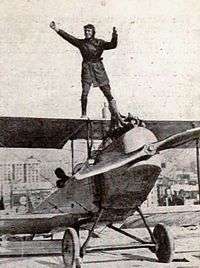Frank Clarke (pilot)

Frank Clarke (29 December 1898 - 12 June 1948) was a Hollywood stunt pilot, actor,[1] and military officer. His most prominent role was as Leutnant von Bruen (and double for von Richthofen in combat scenes) in the 1930 production Hell's Angels, but he flew for the camera and performed stunts in more than a dozen films in the 1930s and '40s. He was killed in an airplane crash near Isabella, California, in 1948.[2]
Background
Clarke was born near Paso Robles, California, on 29 December 1898.
Hollywood
In his biography of pilot Paul Mantz, aviation author Don Dwiggins observed that the "Undisputed king of the Hollywood stunt pilots when Mantz arrived was Frank Clarke, a tall, handsome, part-Indian ex-cowboy who melted the hearts of women and froze the hearts of men. A 'born' pilot, Clarke was hopping passengers at Venice Field in 1918 on the same day he soloed. His good looks won him the lead role in the flying film serial Eagle of the Night (1928) at Pathé Studios.
"In addition, Clarke insisted on writing his own scripts, calling for such suicidal stunts as landing on top of a speeding passenger train. He came closer to disaster on this one, when a wheel stuck between two cars; it came free when the train rounded a curve."[3]
Clarke was a charter member, along with Pancho Barnes, of the Associated Motion Picture Pilots.
Clarke's first film piloting job listed by IMDB is in The Cloud Rider, in 1925, but the Los Angeles Times published details of Clark (he added the last 'e' later) flying a Curtiss JN-4D off of the roof of the incomplete 10-story Railway Building in downtown Los Angeles for the silent film Stranger Than Fiction on 14 December 1920.[4] His last was an uncredited appearance in RKO's Walk Softly, Stranger, filming of which was completed in June 1948 but which was not released by studio head Howard Hughes until 1950.
In between, he was involved with such productions as The Air Patrol (1928), Eagle of the Night (1928), Hell's Angels (1930), The Lost Squadron (1932), Ace of Aces (1933), the 1935 serial Tailspin Tommy in the Great Air Mystery, Men with Wings (1938), and The Flying Deuces (1939).
War
"When World War II began, Clarke enlisted in the Air Force. He rose to the rank of major while teaching his seat-of-the-pants skills to young pilots."[5]
Lt. Col. Paul Mantz, commanding officer of the First Motion Picture Unit, brought Maj. Frank Clarke into the unit to take charge of the Flight Echelon. Unfortunately, Clarke and Mantz had been bitter pre-war Hollywood rivals and Clarke resented being subordinate to Mantz in both position and rank. Clarke repaid his rival by framing him on charges of misconduct, and although Mantz was not found guilty of any infractions, the mere fact of the investigation led to Mantz being eased out of the commanding officer's slot in December 1943.[6]
Death
On 13 June 1948, Clarke was flying his Vultee BT-13 Valiant to Kernville, California, with a pilot friend, Mark Owen. They were on their way to visit a retired fellow-Hollywood flying buddy, Frank Tomick. Clarke decided it would be amusing to drop a bag of manure on Tomick's cabin.
"Clarke pushed the throttle forward in what was to have been a dive-bombing run. Tomick watched in horror as the plane plunged straight down into the ground and exploded. The sack of fertilizer had jammed behind the control stick, locking it.[5]
The San Bernardino Daily Sun reported on 14 June 1948, that sheriff's deputies "investigated the crash of a converted Army training plane in which two Hollywood movie studio workers were killed. The victims were identified as Frank Clark, [sic], stunt pilot, and Mark Owens, 51, both of Los Angeles."[2]
Clarke was interred at Forest Lawn Memorial Park in Glendale, California.[7]
Commemoration
"The propeller from Clarke's BT-13 is mounted in concrete in an area known as Dutch Flats, west of Lake Isabella in the Green Horn Mountains. Etched in the propeller are his name and Owen's."[5]
References
- ↑ Dwiggins, Don, "Hollywood Pilot: The Biography of Paul Mantz", Modern Literary Editions Publishing Company, New York, New York, by arrangement with Doubleday & Company, Inc., 1967, Library of Congress card number 67-12309, page 42.
- 1 2 United Press, "Two Movie Workers Die in Plane Crash", San Bernardino Daily Sun, San Bernardino, California, Monday 14 June 1948, Volume LIV, Number 247, page 1.
- ↑ Dwiggins, Don, "Hollywood Pilot: The Biography of Paul Mantz", Modern Literary Editions Publishing Company, New York, New York, by arrangement with Doubleday & Company, Inc., 1967, Library of Congress card number 67-12309, pages 41-42.
- ↑ Los Angeles Times
- 1 2 3 Rasmussen, Cecilia, Times Staff Writer, "Trailblazing Stunt Pilot Was the Stuff Movies Are Made of", Los Angeles Times, Los Angeles, California, Sunday 21 October 2001.
- ↑ Dwiggins, Don, "Hollywood Pilot: The Biography of Paul Mantz", Modern Literary Editions Publishing Company, New York, New York, by arrangement with Doubleday & Company, Inc., 1967, Library of Congress card number 67-12309, pages 132-154.
- ↑ findagrave.com entry
External links
- Frank Clarke on IMDb